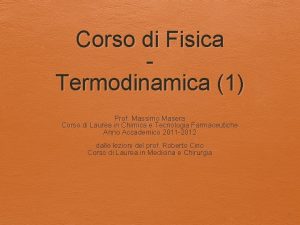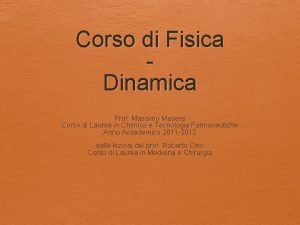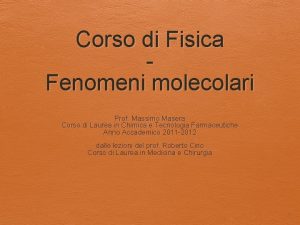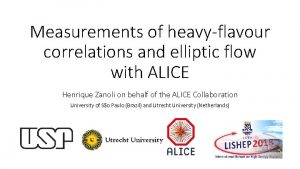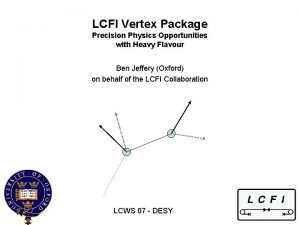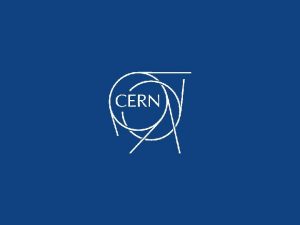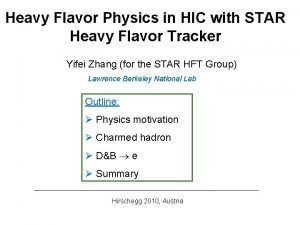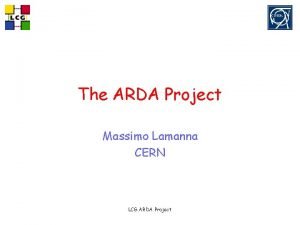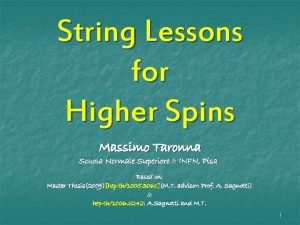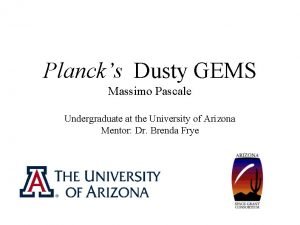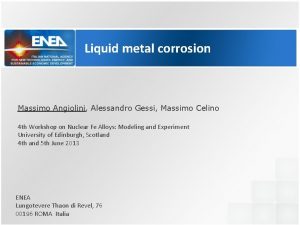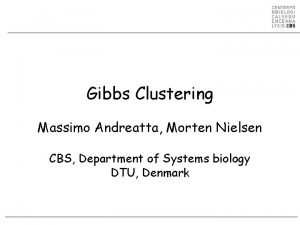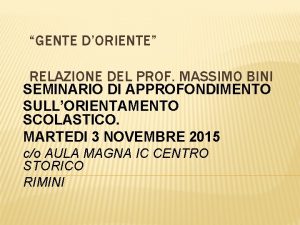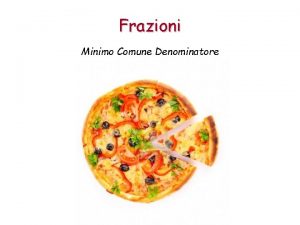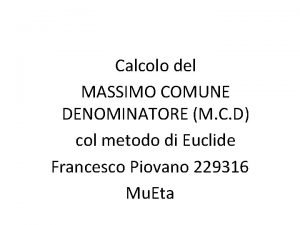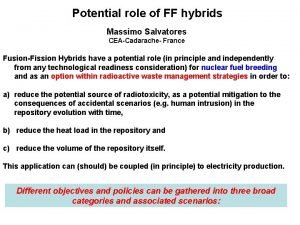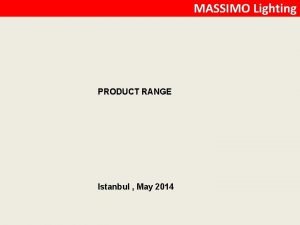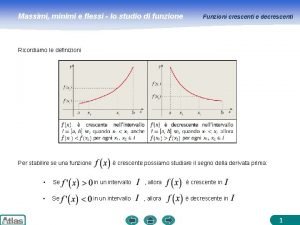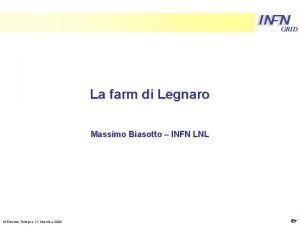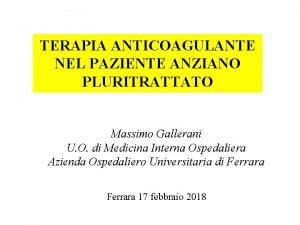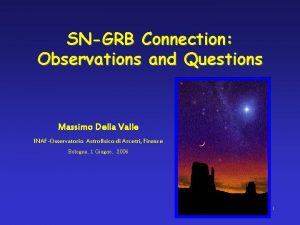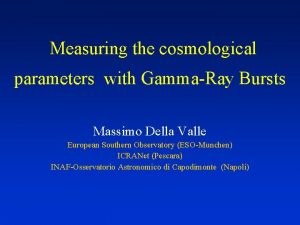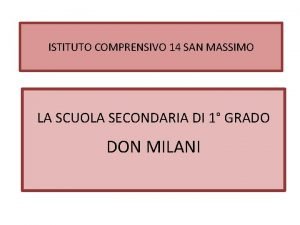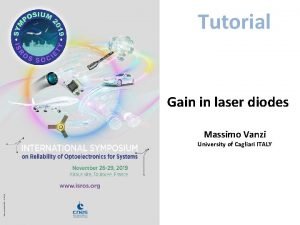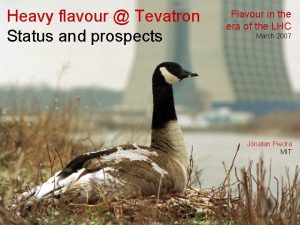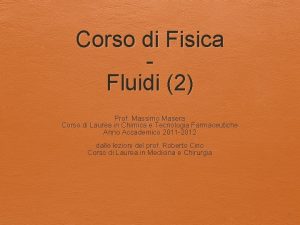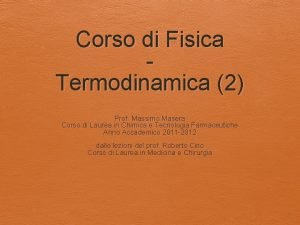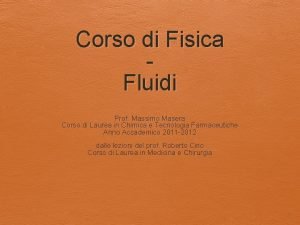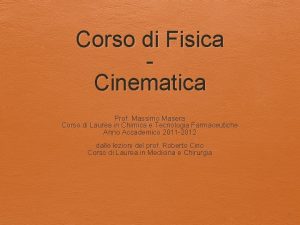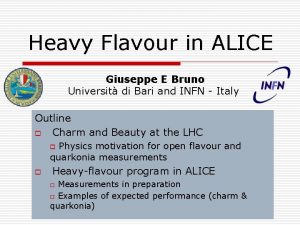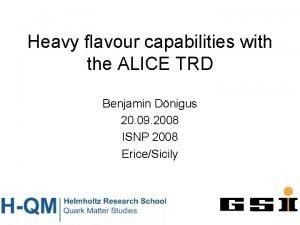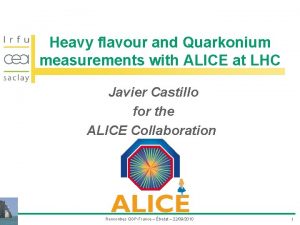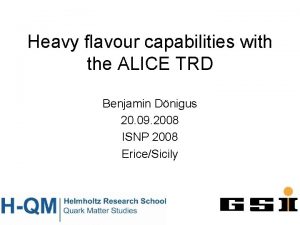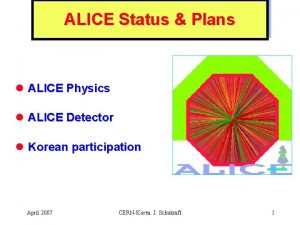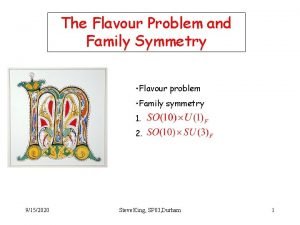Heavy Flavour Physics in ALICE Massimo Masera University










































- Slides: 42

Heavy Flavour Physics in ALICE Massimo Masera University and INFN, Torino - Italy for the ALICE Collaboration 9 Feb 2008 M. Masera Heavy Flavour in ALICE

Contents • Heavy Flavours at the LHC • ALICE • Open Flavours § Physics motivations § Hadronic charm • Examples: D 0 K- +, D+ K- + +, Ds+ K+K- + § B e+X and B +X • Quarkonia § Quarkonia to dielectrons at midrapidity § Quarkonia to dimuons at forward rapidities • J/ and polarization • J/ from beauty • Conclusions 9 Feb 2008 M. Masera Heavy Flavour in ALICE 2

Yields at LHC energies Predicted yields for charm and beauty system, s pp, 14 Te. V Pb-Pb (0 -5%), 5. 5 Te. V 11. 2 / 0. 5 4. 3 / 0. 2 0. 16 / 0. 007 115 / 4. 6 üNLO p. QCD calculations [Mangano, Nason, Ridolfi, NPB 373 (1992) 295. ] theoretical uncertainty: factor 2 -3 üFrom p+p to Pb-Pb: binary scaling + shadowing (EKS 98) ü HF are abundantly produced at the LHC: üProbe unexplored small-x region with HQs at low p. T and/or forward y down to x~10 -4 with charm, 9 Feb already at 2008 y=0 muon arm Central barrel M. Masera Heavy Flavour in ALICE acceptance for charm and beauty 3

ALICE • ALICE channels: Time Of Flight (TOF) § electronic (|h|<0. 9) § muonic (-4<h<-2. 5) § hadronic (|h|<0. 9) • ALICE coverage: § Extends to low-p. T region § central and forward rapidity regions Transition Radiation Detector (TRD) Muon Arm - see B. Espagnon’s talk • Precise vertexing to identify D (c ~ 100 -300 m) and B (c ~ 500 m) decays Time Projection Chamber (TPC) Inner Tracking System (ITS) 9 Feb 2008 M. Masera Heavy Flavour in ALICE 4

Track impact parameter in Pb-Pb • Resolution on track impact parameter • thanks to the 2 layers of Silicon Pixel Detectors Interaction point (primary vertex) primary vertex § x and y coordinates with high precision averaging over fill. Good position stability expected for LHC beam, sbeam=15 m § z coordinate measured from cluster correlation on the two layers of SPD track impact parameter central Pb–Pb =L decay length q decay vertex rf : 0 5 m PI z: 4 XE 25 L CE m LL < 60 mm (rf) for pt > 1 Ge. V/c 9 Feb 2008 Two layers: r = 4 incm M. Masera Heavy Flavour ALICE r = 7 cm 5

Open Flavours 9 Feb 2008 M. Masera Heavy Flavour in ALICE

Physics motivations • p-p § Measurement of HF production test of p. QCD calculations § Baseline for AA • A-A § Study of the hot and high density medium produced in central A-A collisions • Initial (also in p-A) and final state effects • Effects of the medium on fragmentation § Important for quarkonium physics • Normalization • B J/ + X • p-A § To disentangle initial and final state effects induced by the medium 9 Feb 2008 M. Masera Heavy Flavour in ALICE 7

From p-p to A-A • Zero order approximation: binary scaling with Ncoll • Initial state effects (also in p-A) antishadowing § PDFs in nucleus different from PDFs in nucleon • Anti-shadowing and shadowing § k. T broadening (Cronin effect) § Parton saturation (Color Glass Condensate) • Final state effects (only in A-A) shadowing RHIC LHC SPS EMC § Energy loss in medium § In medium hadronization • Recombination vs. fragmentation 9 Feb 2008 M. Masera Heavy Flavour in ALICE 8

Suppression observed at RHIC • Measurement done via non photonic electrons • RAA good agreement between Phenix and Star STAR : PRL 98, 192301 (2007) PHENIX : PRL 98, 172301 (2007) • Suppression compatible with pure charm … But b expected to dominate for p. T>4 Ge. V • to disentangle c/b full reconstruction of D mesons good track impact parameter resolution is needed • Radiative Eloss CR • CR=4/3 for q • CR=3 for gluons Non photonic electrons suppressed as light hadrons at high p. T large quark contribution for light flavours? 9 Feb 2008 At the LHC gluon M. contribution Masera Heavyshould Flavour be in ALICE dominant 9

D 0 K - + • Golden channel for open charm • S/B ≈ 10% • Significance for 1 month Pb-Pb run: S/√(S+B) ≈ 40 Sensitivity w. r. t. p. QCD statistical. 1 year at standard luminosity (109 pp events) Sensitivity w. r. t. p. QCD 1 year at standard luminosity (109 pp events) statistical. systematic. 9 Feb 2008 M. Masera Heavy Flavour in ALICE 10

D+ K- + + and Ds+ K+K- + D+ K - + + • Measure D 0/D+ instead of relying on l l l p-p @ 14 Te. V + + K- + + Ds+ K+DK- Fragmentation/recombination Experimentally accessible? Ds+ (c ~ 150 µm) K-K+ + with BR ~ 4. 4 % l but mostly resonant decays: + or K 0* K + favours backkground rejection l 9 Feb 2008 MKK (Ge. V/c 2) Under study • • 2<p. T<3 Ge. V/c Pythia Larger c ≈300 m w. r. t. D 0 Larger combinatorial background Smaller <p. T> of the decay products Performance comparable with D 0 K- + Ds+ as probe of hadronization? M. Masera Heavy Flavour in ALICE 11 MK (Ge. V/c 2)

Beauty to e/ • B e+X § e± identification from TRD and d. E/dx in TPC § impact parameter from ITS § Subtraction of charm contribution • B +X § Muon spectrometer § b contribution dominant at high p. T § measurement of c contribution at low p. T difficult due to high background § Crosscheck: muon pairs from B decays § See B. 9 Espagnon’s Feb 2008 talk Expected ALICE performance (1 month Pb-Pb) S/(S+B) M. Masera Heavy Flavour in ALICE S per 107 central Pb-Pb events 12

Performance for D and B quenching Colour charge dependence Mass dependence mb = 4. 8 Ge. V Statistical error corresponding to 107 Pb-Pb and 109 p-p events 9 Feb 2008 M. Masera Heavy Flavour in ALICE 13

Quarkonia 9 Feb 2008 M. Masera Heavy Flavour in ALICE

Quarkonia detection in ALICE • Quarkonia detected via § e+e- channel: electrons tracked in the central barrel, identified with the Transition Radiation Detector and the Time Projection Chamber § + - channel: forward rapidities with the Muon Spectrometer 9 Feb 2008 M. Masera Heavy Flavour in ALICE 15

Acceptances J/ Dielectron trigger: p. T cut=3 Ge. V/c on individual electrons J/ Dimuon trigger. p. T cut = 1 Ge. V/c (2) for J/ ( ) 9 Feb 2008 M. Masera Heavy Flavour in ALICE 16

Quarkonia to dielectrons: Pb-Pb Dielectron invariant mass spectrum in top 10% central collisions after one “ALICE-year” of Pb-Pb data taking Zoom in the J/Y region Zoom in the region 9 Feb 2008 M. Masera Heavy Flavour in ALICE 17

Quarkonia to dimuons p-p @ 14 Te. V One year of data taking -J/Y: 2. 8 106 - : 2. 7 104 Invariant mass resolution: • J/Y peak: ~ 70 Me. V/c 2 • peak: ~ 100 Me. V/c 2 9 Feb 2008 M. Masera Heavy Flavour in ALICE Pb-Pb @ 5. 5 Te. V One year of data taking -J/Y: excellent (670. 000) - Y’: marginal - : ok (7000) - ’: low (2000) - ’’: very low (1000) 18

J/ and polarization • p-p collisions: § Polarization measurements are a test for different quarkonia production mechanisms, since different models predict different polarizations • A-A collisions: § A significant J/ polarization in heavy-ion collisions is expected in case of QGP formation (Phys. Rev. C 68 061902 (2003)) polariz. pp@ 14 Te. V vs p. T = -1 Without backgorund subtraction (S/B=0. 2) One year data taking 9 Feb 2008 With backgorund subtraction meas- gen • See poster by E. Scomparin J/ polariz. AA@ 5. 5 Te. V vs M. Masera Heavy Flavour in ALICE 19

B J/ + X • More “exclusive” than B e/µ + X § better handle on B momentum distribution • Preliminary pp study: pseudoproper decay time (à la CDF) CDF (data) p. T>0 ALICE (prelim. simulation) 20

Conclusions • HF are a powerful tool to study the strongly interacting • • medium produced in Heavy Ion Collisions at the LHC High rates of Heavy Flavours are expected at LHC ALICE is well suited for HF physics: § Excellent vertexing and tracking capabilities § Exploits both electron and muon channels in different rapidity regions § PID with several complementary techniques (d. E/dx, TOF, TRD) • Present simulations focused on the effects of realistic calibration and alignment (see poster P 174 by S. Moretto) 9 Feb 2008 M. Masera Heavy Flavour in ALICE 21

BACKUP 9 Feb 2008 M. Masera Heavy Flavour in ALICE

LHC System s. NN L 0 (*) Run sgeom (b) (Te. V) (cm-2 s-1) time (s/year) p-p 14 1034 107 0. 07 Pb-Pb 5. 5 1027 106 7. 7 (*) L 0 (ALICE)= 1031 • Other collision systems foreseen: p-A, lighter ions and energies • Running time: 4 weeks/year integrated luminosity in one year: 0. 7 nb-1 for Pb-Pb • One Heavy Ion dedicated experiment: ALICE. Both CMS and ATLAS have also a Heavy Ion programme • Initial condition different w. r. t. RHIC • greater energy density, temperature, size and lifetime of the fireball • Significant contribution of hard processes to the total AA cross section: 9 Feb 2008 M. Masera Heavy Flavour in ALICE 23

HF: general Physics motivations • Goal: study the properties of the medium § Charm and beauty are abundantly produced at LHC § § Heavy flavours are produced (early) in the initial collisions mainly via gluon fusion they are hard probes § Production yield in p-p from p. QCD: • Naive expectation. Binary scaling to A-A § They travel in the medium experience the full collision history 9 Feb 2008 M. Masera Heavy Flavour in ALICE 24

Heavy Flavours in ALICE • ALICE channels: § electronic (|h|<0. 9) § muonic (-4<h<-2. 5) § hadronic (|h|<0. 9) • ALICE coverage: § Extends to low-p. T region § central and forward rapidity regions • Precise vertexing to identify D (c ~ 100 -300 m) and B (c ~ 500 m) decays 9 Feb 2008 M. Masera Heavy Flavour in ALICE 25

Baseline: p+p collisions Hard processes (q-qbar annihilation, gluon fusion) occurring at short space-time scale (~1/2 mq) s /2 b or c quarks xa M q B or D mesons s /2 xb q M Cross section evaluation factorized p. QCD: Cross section to produce hadron M 9 Feb 2008 Parton Distribution Functions – xa and xb are parton momentun fractions in the colliding hadrons Cross section at parton level: p. QCD. Currently NLO used as a baseline for ALICE. FONLL better description at high p. T M. Masera Heavy Flavour in ALICE Fragmentation function (non perturbative) 26

p+p: charm cross section üFONLL: ü beauty production well described at Tevatron (J/ψ from b decay) ücharm production underpredicted at Tevatron üRHIC p+p data underpredicted üDiscrepancy between Phenix and Star Cacciari, Frixione, Mangano, Nason and Ridolfi, JHEP 0407 (2004) 033 CDF, PRL 91 (2003) 241804 FONLL: Cacciari, Nason PRL 98, 192301 (2007) 9 Feb 2008 M. Masera Heavy Flavour in ALICE 27

D/B Mesons Main selection tool for D/B mesons: displaced secondary vertices Total yield for Pb-Pb central interactions (5% sinel) at 5. 5 Te. V D mesons: ü c ~ 100 – 300 m ü Significant BR for ü ü ü B mesons: ü c ~ 500 m ülarge BR in semileptonic decay channels (20%) • inclusive single electron measurement of B e e X • inclusive muon/dimuon measurement of B X Total yield for Pb-Pb central interactions (5% sinel) at 5. 5 Te. V 9 Feb 2008 M. Masera Heavy Flavour in ALICE 28

D + K - + + • Measure D 0/D+ instead of relying on Pythia Larger c ≈300 m w. r. t. D 0 Larger combinatorial background Smaller <p. T> of the decay products Performance comparable with D 0 K- + p-p @ 14 Te. V Significance S/ (S+B) for 2<p. T<3 Ge. V/c cosqpoint. CUT • • 2<p. T<3 Ge. V/c (normalized to 107 Pb. Pb events) 9 Feb 2008 M. Masera Heavy Flavour in ALICE d CUT(mm) Dist prim. Sec. ( m) qpoint p T D+ 29

Ds+ K+K- + l Ds + as probe of hadronization? string fragmentation: cs / cd ~ 1/3 lafter decays: Ds+ (cs) / D+ (cd) ~ 0. 6 lfrom recombination: cs / cd ~ N(s) / N(d) l. How large at LHC? lexperimentally accessible? (c ~ 150 µm) K-K+ + with BR ~ 4. 4 % lbut mostly resonant decays: + or K 0*K+ favours bkgnd rejection MKK (Ge. V/c 2) l. Ds+ MKK (Ge. V/c 2) lfrom 9 Feb 2008 M. Masera Heavy Flavour in ALICE MK (Ge. V/c 2) 30

B mesons via B e e X (I) Inclusive measurement of electrons coming from semielectronic decay of beauty hadrons Ø need good electron identification: combined PID in TPC (d. E/dx) + TRD • key selection point: again good measurement of the track impact parameter d 0 distributions for “electrons” from different sources: rec. track Primary Vertex e B d 0 9 Feb 2008 normalized to the M. Masera Flavour in ALICE Distributions same integral. Heavy in order to compare their shapes X 31

B mesons via B e e X (II) Selection of the beauty electron candidates in 3 steps 1) Electron PID: reject most of the hadrons 2) Impact parameter cut: reduce charm and bkg electrons 3) Subtract (small) residual background |d 0| distributions for “electrons” from different sources: rec. track e beauty dominates left charm left bkg 9 Feb 2008 Primary Vertex d 0 M. Masera Heavy Flavour in ALICE B X 32

B mesons via B e e X (III) Results for beauty in Pb-Pb p. T-differential electron cross section reconstructed from ~ 1 to 20 Ge. V/c expected statistics and systematic uncertainties 107 central (0 -5%) Pb-Pb events 9 Feb 2008 M. Masera Heavy Flavour in ALICE 33

HF to muons • Single muons from beauty • • are dominant at high p. T fit on distribution tail Muons from charms are dominant at low p. T difficult measurement due to large background Muon pairs from B: BDsame B µ+ + D + X µ- + X BDsame BBdiff + X 9 + µ BB Feb 2008 µ-M. +Masera X Heavy Flavour in ALICE 34

HF to single muon in p-p • Signal: from b/c decays • Background: § from /K decays • Can be extracted from data Slices in p. T. Correct for diamond shape § from the absorber • Subtraction: tracks do not point to the vertex, no FMD hits • Good preliminary results: 9 Feb 2008 M. Masera high Heavy Flavour in ALICE statistics needed 35

Quarkonia to dimuons Centrality dependence of J/ and normalized to unlike sign dimuon rates from beauty Shadowing + 2 different suppression scenarii: 1. High dissociation temeperature 2. Low dissociation temperature Error bars 1 month data taking Assumptions 1. Perfect subtraction of combinatorial background 2. Zero nuclear absorption cross section 9 Feb 2008 M. Masera Heavy Flavour in ALICE 36

Quarkonia to dielectrons: Pb-Pb Dielectron invariant mass spectrum in central collisions after one “ALICE-year” of Pb-Pb data taking 9 Feb 2008 M. Masera Heavy Flavour in ALICE 37

Perspectives for D± elliptic flow • GOAL: GOAL Evaluate the statistical error bars for measurements of v 2 for D± mesons reconstructed from their K decay in Pb-Pb collisions Ø v 2 vs. centrality (b=collision impact parameter) Ø v 2 vs. p. T in different centrality bins • HOW: HOW fast simulation to generate: § ND+ (Dp. T, Db) with an angular distribution d. ND/dj = v 2 D, in cos [2(j-YRP)] § For each D+: an event made of Ntracks is superimposed d. N/dj = v 2 ev, in cos [2(j-YRP)] § Inputs of the simulation: ND+ (Dp. T, Db) , v 2 D, in, Ntracks , v 2 ev, in § Outputs: v 2 D measured. 9 Feb 2008 M. Masera Heavy Flavour in ALICE 38

v 2 vs. p. T How to increase the statistics? Large stat. errors on v 2 of D± → K in 2· 107 MB events • Sum D 0→K and D±→K § Sufficient for v 2 vs. centrality • Semi-peripheral trigger 6<b<9 fm § v 2 vs. p. T that would be obtained from 2· 107 semi-peripheral events (e. g. 6<b<9 fm) MB trigger 9 Feb 2008 Semi-peripheral trigger M. Masera Heavy Flavour in ALICE 39

B elliptic flow üv 2 evaluated from B e+X ü Pb-Pb centrality: 20 -60% 1 year at nominal luminosity 9 Feb 2008 M. Masera Heavy Flavour in ALICE 40

Kinematical distributions: prompt J/ versus secondary J/ • “pseudo proper • decay time” x Primary J/ Secondary J/ 9 Feb 2008 M. Masera Heavy Flavour in ALICE 41

How to measure the fraction of secondary J/ from b-hadron decays, one should fit simultaneously ü the invariant mass spectrum ü one distribution which can discriminate prompt from detached J/ (e. g. x or d 0 e+·d 0 e-) Events/10 Me. V • In order to extract the fraction f. B of J/ • the tails of the M(e+e-) distribution measures the percentage of background 9 Feb 2008 M. Masera Heavy Flavour in ALICE 42
 Massimo masera
Massimo masera Guadagno meccanico leve
Guadagno meccanico leve Forza normale fisica
Forza normale fisica Massimo masera
Massimo masera Iteenary
Iteenary Heavy flavour
Heavy flavour Heavy flavour
Heavy flavour Ratey algebra 2
Ratey algebra 2 Condor job flavour
Condor job flavour Flavour enhancer 627 and 631 side effects
Flavour enhancer 627 and 631 side effects University physics with modern physics fifteenth edition
University physics with modern physics fifteenth edition Charm mesom
Charm mesom Why does it happen
Why does it happen Example physics ia
Example physics ia Massimo lamanna
Massimo lamanna Massimo taronna
Massimo taronna Massimo falanga
Massimo falanga Massimo pascale
Massimo pascale Silvia bandinu
Silvia bandinu Alessandro gessi
Alessandro gessi What are 3 domains
What are 3 domains Massimo bini professore
Massimo bini professore Che cos'è il minimo comune denominatore
Che cos'è il minimo comune denominatore Massimo strino kaleidoscopes
Massimo strino kaleidoscopes Massimo moser
Massimo moser Mcd definizione
Mcd definizione Massimo franceschetti
Massimo franceschetti Massimo mitolo
Massimo mitolo Massimo salvatores
Massimo salvatores Massimo mellacina
Massimo mellacina Massimo lighting
Massimo lighting Come trovare massimi minimi e flessi
Come trovare massimi minimi e flessi Massimo biasotto
Massimo biasotto Vorrei una voce massimo ranieri
Vorrei una voce massimo ranieri Massimo ligazzolo
Massimo ligazzolo Massimo paone
Massimo paone Massimo gallerani età
Massimo gallerani età Massimo della gamma
Massimo della gamma Massimo della gamma
Massimo della gamma Massimo villari
Massimo villari Istituto comprensivo san massimo
Istituto comprensivo san massimo Massimo mariano psicologo
Massimo mariano psicologo Massimo vanzi
Massimo vanzi
